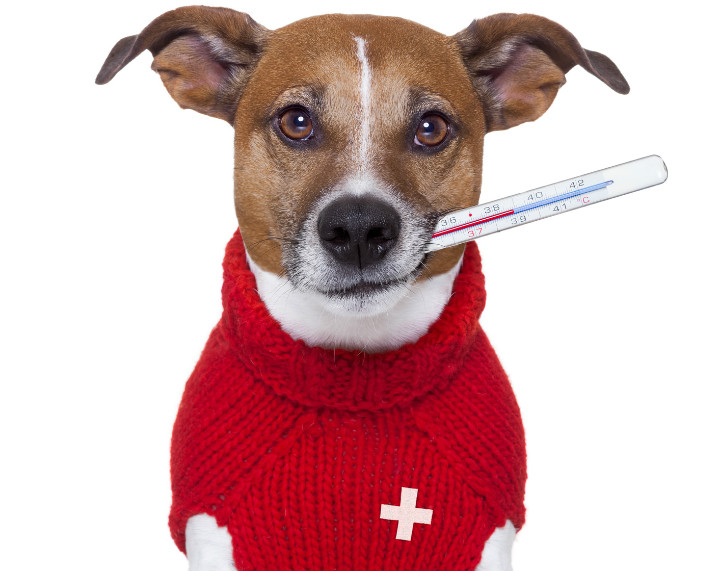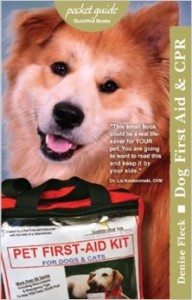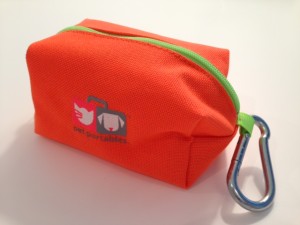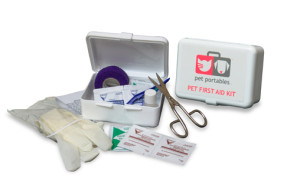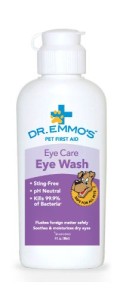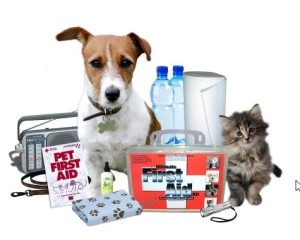
Who wants to even think about it. According to statistics, 9 dogs out of 10 are expected to have an emergency in their lifetime. Jeez. When I read that, and started exploring information on emergency dog care, how unprepared I am made me very nervous. So, I’ve vowed to get ready, just in case the unthinkable happens. I want to share with you what I’m learning/doing, so we can be prepared together. According to the American Animal Hospital Association (AAHA), 25% more animals could be saved if just one Pet First-AID technique was applied prior to getting Veterinary care.
I’m going to share what constitutes a dog emergency, what our first aid kits should contain and some suggestions about first aid products I’ve found. Let’s get right to this very important and sobering subject. More light and fun fashion news soon!
What are some signs your dog needs emergency care?
- Pale gums/dehydration
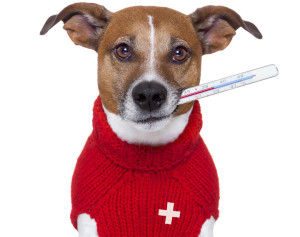 Rapid breathing or difficulty breathing
Rapid breathing or difficulty breathing- Restlessness, panting, inability to lie down comfortably, unsuccessfully attempting to vomit, and abdominal distention are symptoms of bloat, which is deadly.
- Weak or rapid pulse
- Change in body temperature
- Difficulty standing
- Apparent paralysis
- Loss of consciousness
- Seizures
- Excessive bleeding
- Protracted vomiting/diarrhea
- Difficulty urinating
- Change in appetite – if a chowhound doesn’t eat or a fussy eater goes without food for more than one day
- Your dog appears to be in pain
A Powerful Tool in Your Arsenal
It’s always really helpful for me to have one place to go that consolidates the basics of what I need to know. That one valuable tool for me is a Pocket Guide book by an industry colleague, Denise Fleck, called Dog First AID & CPR. Denise, besides being a big animal rescue volunteer for many years, is also an animal care instructor, specializing in Pet First AID & CPR, and caring for senior pets. She’s shared some of her animal life-saving skills on Animal Planet, CNN, PBS and numerous news segments, as well as assisting Homeland Security with their K9 First-AID Program for Border Patrol Handlers. If you want to know more about Denise, visit her site at www.sunnydoglink.com.
In her book, one of the first things she talks about is teaching ourselves how to check our dog’s vital signs. They include:
- Taking your dog’s pulse – should be between 90-160 beats per minute for a small dog, and between 65-90 beats per minute for a large dog.
- Checking respiration – dogs range between 10-40 inhalations per minute, with younger and smaller canines breathing faster than older/larger ones.
- Taking his/her temperature – your dog’s temperature should be between 100.4°F – 102.5°F (38°C – 39.16°C).
- Determining hydration – by pinching a fold of skin at the nape of the neck and releasing. If well hydrated, the skin should quickly fall back into place. For loose-skinned breeds or older dogs who have lost skin elasticity, carefully feel the dog’s gums. If dry or sticky, they may be dehydrated.
- Checking capillary refill time – carefully lift the dog’s lip and press on its gums, above the teeth, with your index finger until the gums lighten. Release the pressure and the color should return to the gums in 1-2 seconds. Capillary refill time indicates whether the circulation is sufficient, meaning is the heart pumping strongly enough to send blood throughout the body.
She goes through a step-by-step process of how to do each with pictures, and has provided a chart where you can mark your pet’s vitals at rest and after play, so you have a benchmark. She also stresses the importance of knowing where a 24-hour emergency veterinary practice is nearby, and driving there, so you know exactly where you’re going when you are too upset to think about it, should an emergency occur. Here are a few things she suggests checking on in advance with the 24 hour facility:
- Know where it’s located
- Know where to park
- Find out what services they provide, such as x-rays, MRI’s, transfusions. Do they carry antivenin for snake bites?
- What are their payment options
Other emergencies the book covers:
The book also includes what constitutes extreme emergency situations and what to do on the way to the vet:
- Choking Incidents and the doggy Heimlich Maneuver
- Rescue Breathing & CPR. Denise does recommend taking a class on Dog First AID and CPR, so you can gain the confidence and skill to perform these tasks well.
- Bleeding Injuries
- When Your Dog Gives Birth
- Heat and Cold Injuries, like heatstroke and frostbite
- Intestinal Upsets
- Poisoning
- Seizures
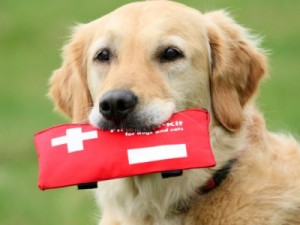 I can’t say enough good things about this little book. Now, on to our emergency kit.
I can’t say enough good things about this little book. Now, on to our emergency kit.
What should our first aid kit contain?
According to Denise, having the right tools for the job at hand can help alleviate pain and further injury to your dog or puppy. This list for your kit covers everything from bandaging a wound, pulling a tick or soothing an upset tummy.
- 3% Hydrogen Peroxide to induce vomiting
- Eye Wash♥Cold Pack♥Antibiotic Ointment or Gel
- 4″x4″ Gauze Squares and Gauze Roll
- Adhesive Tape or Self-adhering Bandage
- Needle-less Syringe or Eye Dropper
- Digital Thermometer
- Styptic Powder to stop bleeding toenails
- Scissors & Tweezers
- Antihistamine & Antacid Tablets
- Leash to wrangle or muzzle a pet
- Towel or blanket to use as a stretcher or to wrap your dog
- Water bowl, Bottled Water, Electrolyte Replenisher
Some products I like for a first aid kit
Pet Portables
There’s a new company called Pet Portables, making an emergency kit if you’re on the go. There are a couple of different sized kits, from the all in which has a broader spectrum of products, to the little 4″x 2″ canvas pouch that comes in a variety of cool colors. The company gave us a neon orange kit to try. Each small kit has a carabiner, so you can easily attach to your jeans, purse or backpack.
The small kit retails for $16.95 and contains:
- two 2″x2″ gauze pads to apply to wounds
- two antiseptic towelettes to clean wounds/hands
- one insect sting wipe
- one iodine wipe for sterilization
- one certisporane antibiotic cream
- one 1″x5yd. coflex secure bandage
- one plastic tweezer for splinter or tick removal
The larger kit retails for $24.95 and contains:
- 1 bottle styptic powder (toenail bleeding)
- 1 pair latex gloves (personal protection)
- 2 pvp Iodine wipes (sterilization)
- 2 insect sting wipes (apply to bites/stings)
- 2 2”x2” gauze pads (apply to wounds)
- 1 pair scissors (trim hair and cut bandage tape)
- 2 antiseptic towelettes (clean wound/hands)
- 3 cotton swabs (apply ointment/creams)
- 2 green soap towelettes (clean wounds/hands)
- 1 plastic tweezers (splinter/tick removal)
- 1 1” x 5yd. coflex (secure bandage)
- 1 pet care card and CPR card
- 1 pet kit case
Dr. Emmo’s
Dr. Emmo’s makes products to clean and irrigate wounds, help them heal, to wash eyes and to rinse ears. What I like about these products is the main ingredient is sodium chloride, or salt. I’ve been learning a lot about salt recently, and its power to make us healthy. I’m not talking about table salt, that is iodized, bleached and not healthy at all. I’m referring to sea salt. We’ve been hearing more and more about sea salt – Celtic, Himalayan, Black – and its healthy benefits to lower blood pressure and ease stomach issues due to creating an environment of alkalinity in the system. In an alkaline environment, no disease, whether bacterial or viral, can exists.
So I like that these products use sodium chloride as the main ingredient to flush out and disinfect wounds. The ingredients are safe for your dog to lick, they are anti-biotic free, non-toxic and none of the products sting because they are PH neutral. According to National Sales Director, Robert Brennan, “Our products are the cleanest , safest , most effective way to be prepared for the unexpected. Dr Emmo’s products are a must for every pet parents medicine chest or pet first aid kit.” The line includes:
- Wound Care Wash – for bites, scrapes, cuts, rashes and skin irritations. It’s antimicrobial, which means anti bacterial and anti viral, it kills 99.9% of bacteria including Staph, VRE and MRSA, which are some very nasty germs and fungi, and is safe to use around the mouth, nose and eyes.
- Wound Care Gel – for use after Wound Care Wash. This product moistens, protects and promotes the healing of wounds, rashes, bites, skin irritations.
- Ear Rinse – designed to eliminate a very common bacterial condition in dog’s ears, which can lead to infections in the ear and causes odor. The rinse cleans and disinfects the ears without stinging, it breaks down and removes wax, it also kills infection causing bacteria. It’s non-toxic, anti-biotic free and can be used as often as needed to maintain healthy ears.
-
Eye Care Wash – this is an antibiotic-free, all-natural, topical eye care rinse for use in all animal eyes. It is non-toxic and sting-free. It relieves eye irritation, burning, scratching, while safely killing 99.9% of common animal bacteria and germs that get into pets’ eyes. Sounds good!
Summary
Being prepared for a pet emergency is key. It channels the anxiety we feel in the moment in a direction of action for the good of our baby. I hope this has been educational and helpful. It has for me. I’m going out to buy my supplies and signing up for a Pet First-AID & CPR course.
Will you be creating your pet first aid kit or do you already have one?
Until next time…
(Disclosure: I am an affiliate of Amazon, so any products I suggest that you choose to purchase from a link in this article, I will get a small commission on. This goes towards keeping Bark and Swagger up and running, and towards the animal rescue and advocacy groups I regularly support. Thanks for helping!)


